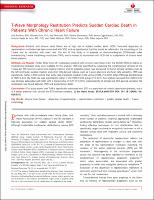Por favor, use este identificador para citar o enlazar este ítem:
https://repositorio.usj.es/handle/123456789/373
| Título : | T-Wave Morphology Restitution Predicts Sudden Cardiac Death in Patients With Chronic Heart Failure |
| Autor: | Ramírez, Julia

Orini, Michele 


Minchole, Ana 

Monasterio, Violeta 


Cygankiewicz, Iwona 

Bayés de Luna, Antonio 

Martinez, Juan Pablo 

Pueyo, Esther 


Laguna, Pablo 

|
| Palabras clave : | Chronic heart failure; Dispersion of repolarization; Sudden cardiac death; T-wave morphology |
| Fecha de publicación: | may-2017 |
| Editorial : | WILEY, 111 RIVER ST, HOBOKEN 07030-5774, NJ USA |
| Citación : | J Am Heart Assoc. 2017;6:e005310. DOI: 10.1161/JAHA.116.005310 |
| Resumen : | Background-Patients with chronic heart failure are at high risk of sudden cardiac death (SCD). Increased dispersion of repolarization restitution has been associated with SCD, and we hypothesize that this should be reflected in the morphology of the T-wave and its variations with heart rate. The aim of this study is to propose an electrocardiogram (ECG)-based index characterizing T-wave morphology restitution (TMR), and to assess its association with SCD risk in a population of chronic heart failure patients. Methods and Results-Holter ECGs from 651 ambulatory patients with chronic heart failure from the MUSIC (MUerte Subita en Insuficiencia Cardiaca) study were available for the analysis. TMR was quantified by measuring the morphological variation of the T-wave per RR increment using time-warping metrics, and its predictive power was compared to that of clinical variables such as the left ventricular ejection fraction and other ECG-derived indices, such as T-wave alternans and heart rate variability. TMR was significantly higher in SCD victims than in the rest of patients (median 0.046 versus 0.039, P< 0.001). When TMR was dichotomized at TMR=0.040, the SCD rate was significantly higher in the TMR >= 0.040 group (P< 0.001). Cox analysis revealed that TMR= 0.040 was strongly associated with SCD, with a hazard ratio of 3.27 (P< 0.001), independently of clinical and ECG-derived variables. No association was found between TMR and pump failure death. Conclusions-This study shows that TMR is specifically associated with SCD in a population of chronic heart failure patients, and it is a better predictor than clinical and ECG-derived variables. |
| URI : | https://repositorio.usj.es/handle/123456789/373 |
| ISSN : | 2047-9980 |
| Aparece en las colecciones: | Artículos de revistas |
Ficheros en este ítem:
| Fichero | Descripción | Tamaño | Formato | |
|---|---|---|---|---|
| Ramirez-2017-Twave-morphology-restitution-predic.pdf | 579,45 kB | Adobe PDF |  Visualizar/Abrir |
Este ítem está sujeto a una licencia Creative Commons Licencia Creative Commons

